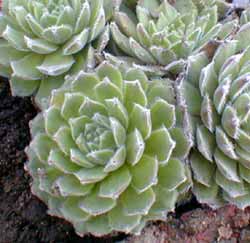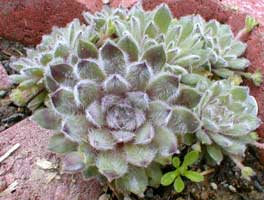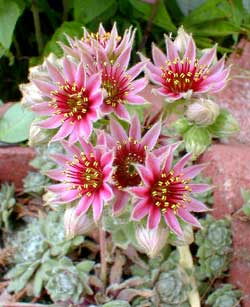
'Witcheri'
Houseleek
"The patching houseleek's head of blossom winks
Through the chinks --
Marks the basement whence a tower in ancient time
Sprang sublime."
-Robert Browning
1812-1889
1812-1889
The hen & chicks variety 'Witcheri' (occasionally "corrected" to be 'Witchery') has a medium-green rosette of pointed leaves. A very winter-hardy & sturdy choice, it can adapt down to USDA zone 3. In our moderate region (Zone 8) it is nearly changeless year-round.
In the first winter portrait, it takes a close inspection to detect the fine white hairs, which are evidence of the Sempervivum arachnoideum or cobweb houseleek in its hybrid history. The second photo, snapped in April, reveals its hursuit coating to be more extreme in spring.
 Much of the year it has mere hints of red blush at underside of tips of each leaf, though in spring it sometimes develops a more visible orangish sheen. Seasonal color changes are not as detectable in our area as they would be in a colder zone, plus any fainter color changes are disguised by the whiteness of its fur.
Much of the year it has mere hints of red blush at underside of tips of each leaf, though in spring it sometimes develops a more visible orangish sheen. Seasonal color changes are not as detectable in our area as they would be in a colder zone, plus any fainter color changes are disguised by the whiteness of its fur.Flower stalks rise from the spreading hen & chicks early in June & by June's end it is in full flower, as shown below. The blooms last the whole of July.
It was developed & introduced to gardening by famed American succulent hybridizers Dr. Bill Nixon & Ed Skrocki. We also have Skrocki's 'Ohioan' houseleek.
The sweet charm of the whole panoply of semperviva types has given rise to folklore which is in the main favorable to their character.
 For instance, to grow them on the roof is said to repel fire, lightning, disease, bad luck, & sorcery. They're alleged to have all manner of medicinal values, some entirely absurd, others perfectly reasonable, hence sometimes called Healing-leaf, & used in much the same ways as are aloe leaves.
For instance, to grow them on the roof is said to repel fire, lightning, disease, bad luck, & sorcery. They're alleged to have all manner of medicinal values, some entirely absurd, others perfectly reasonable, hence sometimes called Healing-leaf, & used in much the same ways as are aloe leaves.In Gaelic it is "Tin Gealach," Moon-cramps, because the leaves were eaten with the belief that they could relieve menstrual pain; or they were called Tineas-na-gealach, "madness of the moon," because their magical potency was keyed to phases of the moon, & may once have been associated with insanity either as cause or cure.
They have been used in all sorts of herbal magic rituals & potions & love-filtres, justifying the present cultivar name 'Witcheri.' Names like Hen & Chickens, alternatively Cat & Kittens, could be conferred upon women, the good luck of this herb extending to safety at childbirth. The blessing of a great many sons & daughters was thought to be assured a household protected by growing these plants at doorways or on roofs.
Though more often associated with Sun-gods & the sun because of their own sun-loving habits, the roundness of the rosettes can indicate either Sun or Moon. The subsidiary association with the Moon recalls their former sacredness not only to Thor but to his wife Freya, herself a sorceress & manipulator of weather, as well as queen of erotic love & fertility, with which houseleeks were likewise associated. In Rune-lore, the houseleek remains the Herb of Freya.